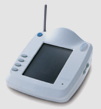 How do you notify people gently about a device alert that doesn't involve an implanted device, but rather a monitoring device developed for the implanted device? Where does a sophisticated implanted defibrillator device end: with the part that's implanted inside a patient or does it include the peripherals that monitor the implanted device, too?
How do you notify people gently about a device alert that doesn't involve an implanted device, but rather a monitoring device developed for the implanted device? Where does a sophisticated implanted defibrillator device end: with the part that's implanted inside a patient or does it include the peripherals that monitor the implanted device, too?These are the issues that have surfaced with a very recent medical device advisory issued by Boston Scientific on 9 September 2009 in a "Dear Doctor" letter (pdf) I managed to find on their website, and was brought to my attention by an anonymous commenter on this blog:
BackgroundHopefully, all patients with these Communicators have been notified, but how are device clinic nurses and physicians supposed to be notified? I checked with our device clinic nurses and they were unaware of this advisory - is it because we have no patients included in this advisory? (I'm not sure). But what I do know is that the potential to miss clinically important information when we increasingly rely on color-coding of parameters on websites to identify out-of-range parameters is something every doctor and device nurse should be made aware, especially since patients move from one location to another or might not have received notification about their communicator.
Boston Scientific defibrillators include a Daily Measurements feature that conducts several diagnostic tests on a daily basis to monitor the implanted defibrillator and leads. At the next in-clinic visit, test results are displayed on the programmer, with out-of-range results appropriately highlighted.
To supplement in-clinic visits, the LATITUDE Patient Management system enables clinicians to monitor the status of the implanted system remotely between clinic visits. Status information from the implanted defibrillator is transferred by an in-home communicator to the LATITUDE Website according to a schedule set by the clinician. If Daily Measurements are programmed On in the implanted defibrillator (nominally On) and the desired Alerts are configured On in LATITUDE, out-of-range Daily Measurements will generate a corresponding Red or Yellow Alert on the LATITUDE Website.
Description
Boston Scientific has determined that alert conditions for a limited subset of out-of-range Daily Measurements related to leads may not be recognized by Model 6476 (United States) or Model 6468 (Europe) LATITUDE in-home communicators. If a communicator fails to recognize a valid alert situation, notification for this or subsequent alerts for the same test will not be displayed for physician review on the LATITUDE Website. However, Daily Measurement values uploaded from the implanted defibrillator will be available from the ALL PATIENTS page after completion of the next full device interrogation, which occurs during Weekly Device Alert Interrogations and scheduled remote follow-ups.
Although a limited subset of alerts may not display on the LATITUDE Website, it is important to note that all Daily Measurement tests within the implanted defibrillator function normally, and results will be displayed as designed when the defibrillator is interrogated with a programmer.
Rate of Occurrence
We have identified 8 missed Red Alerts and 223 missed Yellow Alerts from approximately 19,000 patients in the United States with implanted Boston Scientific defibrillators followed with a LATITUDE Model 6476 Communicator. One missed Yellow Alert has been identified from approximately 50 patients in Europe followed with a LATITUDE Model 6468 Communicator. However, root cause analysis indicates that both communicators are subject to missed alerts at the same rate of occurrence. The observed rate for a missed Red Alert (highest priority) has been approximately 0.01% per month of monitoring. No patient deaths or injuries have been associated with this communicator behavior.
Whether a targeted letter posted on a company's website is adequate notification to electrophysiology personnel nationwide about this type of advisory, whether it affects our patients directly or not, probably is not adequate either.
After all, we're ultimately responsible to our patients.
-Wes
No comments:
Post a Comment
Note: Only a member of this blog may post a comment.